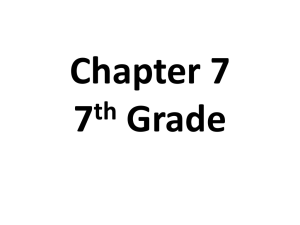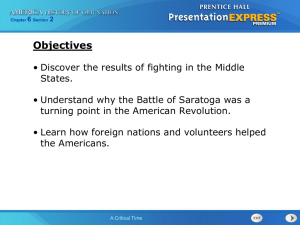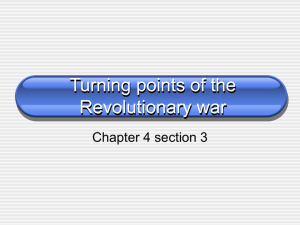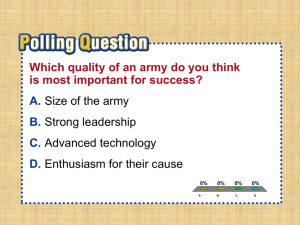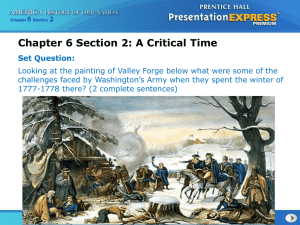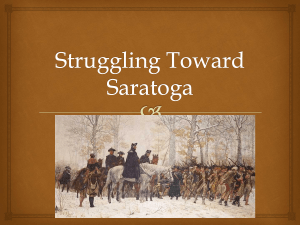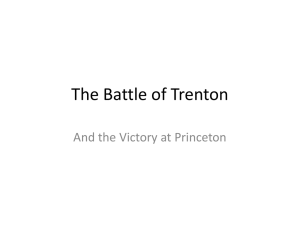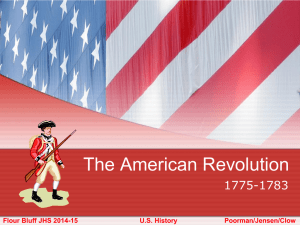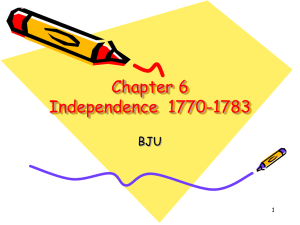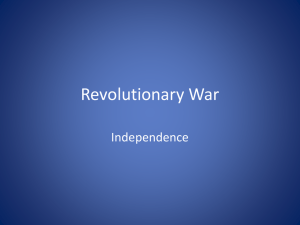4.2 Fighting for Independence
advertisement
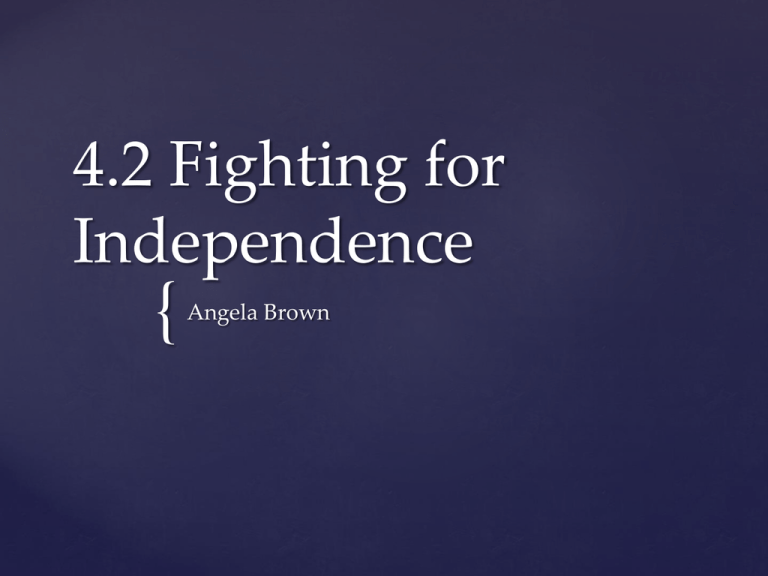
4.2 Fighting for
Independence
{
Angela Brown
1.
2.
3.
Describe the siege of Boston and
its outcome.
List the strengths and weaknesses
of the British and American
forces.
Explain the importance of battles
in the North between 1776 and
1777, including the American
victory at Saratoga.
Learning Targets
{ Bellringer:
“These are the
times that try
men’s souls.”
What is Paine
referring to? What
are the conditions
that try men’s and
women’s souls?
{ Vocabulary
Battle of Bunker
Hill; casualty;
Loyalist;
mercenary; Battle
of Trenton; Battle
of Saratoga
Organize Your Thoughts
King George III had not
expected a war, much less a
long one.
“Once these rebels have felt a
smart blow, they will
submit,” he had vowed after
the clashes at Lexington and
Concord.
After all, the nation he ruled
was the most powerful on
Earth, But the fighting
continued, and even
intensified.
Following the clashes at
Lexington and Concord in
April 1775, as many as 20,000
armed Patriots surrounded
Boston.
Though the Patriots were
disorganized, their presence
prevented the 6,000 British
troops under General Gage
from quickly crushing the
rebellion.
The Siege of Boston
With the main British force
bottled up in Boston, the Patriots
turned their attention to
gathering badly needed military
equipment.
In May a group of Vermont
militia under Colonel Ethan Allen
crossed Lake Champlain and
surprised the British troops at
Fort Ticonderoga in northern
New York.
The capture of the fort provided
the Patriots with cannons and
other supplies.
In June 1775 the Americans occupied two hills north of
Boston.
General Gage decided that the rebels must be driven from
these strategic high grounds.
On June 17, 1775, the British army attacked.
The tightly packed lines of red-coated troops marched up
Breed’s Hill .
1,600 Patriots poured unending musket fire into their ranks.
The advancing troops slowed, stopped, and then fell back.
The Battle of
Bunker Hill
The British launched another assault.
Heavy Patriot fire from the top of the hill drove
them back.
The British commander General William Howe
ordered yet a third attack and took the hill.
The Patriot’s, having used all their ammunition
were forced to retreat.
British forces then quickly overran the second,
weaker Patriot position on nearby Bunker Hill.
Bunker Hill Continued
The British emerged
Victorious from the Battle of
Bunker Hill, but at a
tremendous cost.
Nearly 1.100 of 2,400 British
soldiers had been killed or
wounded.
Patriot casualties – persons
killed, wounded, or missing
- amounted to fewer than
400.
Results
Warning that the Americans
were spirited up by
rage…General Gage asked for
permission to march on Rhode
Island or New York.
General Howe, still confident
of an easy victory, advised
against it.
So for the next nine months
Gage’s small army remained
pinned down in Boston.
In July George Washington
arrived from Philadelphia, where
the Congress had named him
commanding general of the
Patriot forces.
While Gage’s troops remained in
Boston while Washington worked
to transform the Patriot militia
groups into the Continental
Army.
The British Leave Boston
In January 1776, General Henry
Knox arrived outside Boston.
He brought cannons from Fort
Ticonderoga.
Washington placed them on
Dorchester Heights, south of
Boston. From there he could
shell the British forces in the city
and the British ships in Boston
Harbor.
Realizing they could no longer
defend their position, the
British abandoned Boston in
March 1776.
The British fleet moved the
army to the Canadian city of
Halifax, taking along some
1,000 Loyalists, or people who
remained loyal to Great Britain.
The Loyalists had no desire to
be left behind with no one to
protect them from the rebels.
According to John Adams, about
1/3 of the colonists were Patriots.
Another 1/3 were Loyalists, or
Tories as the Patriots called
them.
The remaining 1/3 were neutral
in war.
The British Strengths:
well-equipped, disciplined, and
trained army,
their navy was the world’s
finest.
50,000 Loyalists fought with
them
Some African Americans in the
South help GB who promised
freedom to all slaves who
served their cause.
Strengths and Weaknesses
Most Indian nations believed an American
victory would be harmful to their interests.
In the South and West, the Creeks, Cherokees,
and Shawnees fought alongside British and
Loyalist forces.
In the North the Mohawks, led by Joseph Brant,
and most other Iroquois nations sided with the
British.
The British also hired about 30,000 mercenaries,
foreign soldiers who fight for pay.
The colonists called these troops “Hessians”
because most of their officers came from the
German province of Hesse.
British Strengths continued
The war was not popular in
Great Britain.
Many British citizens resented
paying taxes to fight the war
and sympathized with the
Americans.
British troops had to fight in
hostile territory and British
commanders resisted adapting
their tactics to conditions in
America.
British Weaknesses
Patriot forces were fighting on their own
territory.
Many of their officers were familiar with the
tactics that had worked in the Indian War.
George Washington was an exceptional
commander.
More African Americans served in the Patriot
cause than supported the British.
Washington had some all-black units, but most
served in white units.
Americans Strengths
The Americans lacked a wellsupplied, stable and effective
fighting force.
New recruits were constantly
arriving while experienced
soldiers, their time of service
up, were heading home.
As he tried to plan strategy,
Washington never could be
sure how many troops he
would have.
American Weaknesses
In the summer of 1776, General Retreat from New York
Howe and a large British army
By October the British had captured
appeared off the New York coast.
New York City and driven the
The British had decided to
Continental Army into
concentrate on the Middle
Pennsylvania.
Colonies, where many Loyalists Many troops deserted Washington.
lived.
By the winter of 1776 the entire
In a series of battles, including
Patriot cause seemed on the point of
the Battle of Long Island, some
collapse.
32,000 British and German
Fearing for their safety, members of
troops battered Washington’s
the Continental Congress fled
poorly trained and poorly
Philadelphia.
equipped army.
Read Thomas Paine The Crisis
Fighting in the North
Abandoning the tradition that armies did
not fight during winter, on Christmas night
of 1776 Washington left his Pennsylvania
camp and went on the attack.
Some 2,400 troops were ferried across the
ice-choked Delaware River in small boats.
Early the next morning they surprised about
1,400 Hessians stationed in Trenton, New
Jersey.
Nearly the entire Hessian force was
captured, while the Americans suffered only
five casualties.
The Battle of Trenton
A few days later Washington made a similar attack on nearby
Princeton.
Leaving fires burning so the local Tories would think his
troops were still in camp, he led some 5,000 troops on a
difficult nighttime march.
The next morning, British troops under General Cornwallis
spotted the Patriots and attacked.
The Americans drove them back, inflicting heavy losses, and
captured the town.
These victories boosted Patriot morale and convinced more
Americans to support the cause.
The Battle of Princeton
Despite the increasing Patriot
numbers, the months that
followed held no success for the
Continental Army.
In July 1777 Howe moved his
15,000-man army from New
York to attack the rebel capital at
Philadelphia.
Washington’s 10,500 defenders
were defeated at Brandywine
Creek, on the outskirts of the
city, in early September.
Late in the month, the British
occupied Philadelphia, as the
Congress once again fled.
In early October,
Washington
counterattacked to
drive the British from
the city, but lost again
at the Battle of
Germantown.
Victory at Saratoga
While How was advancing to capture Philadelphia,
another British army was on the move in northern
New York.
Led by General John Burgoyne, its objective was to
cut New England off from the rest of the colonies.
In June Burgoyne moved out of Canada with a
mixed force of about 8,000 British and German
troops, Loyalists, Canadians, and Native Americans
The force quickly recaptured Fort Ticonderoga and
then moved south through the dense New York
forest toward Albany.
A British Attack from the
North
As the Americans retreated in Burgoyne’s path, they destroyed
bridges and felled trees across the road to slow his advance.
Burgoyne’s slow progress caused his army to run low on
supplies.
The colonial force continued to grow, as the Continental Army
and Patriot militias assembled to confront the invaders.
In September the Americans, led by General Horatio Gates,
attacked Burgoyne’s forces.
This series of American victories, took place around Saratoga,
New York.
Finally, on October 17, 1777, surrounded by a force now much
larger than his own, Burgoyne surrendered his army.
It was the biggest American victory yet and it marked the
turning point of the war.
Victory at Saratoga
A few months after declaring independence,
Benjamin Franklin was sent on a mission to
Paris.
France secretly aided the Americans and
Franklin pushed for an open alliance.
The victory at Saratoga convinced the French
the Americans had a chance of winning the
war.
On February 6, 1778, France and the United
States signed a treaty of alliance.
Help from Abroad
The French helped with supplies, loans of money, French troops
and a navy.
Britain had to defend itself in Europe.
Spain joined the French alliance a year later and the Netherlands
in 1780.
From Louisiana, Spanish governor Bernardo de Galvez, had been
secretly aiding the Patriots, attacked British outposts in Florida
and along the Mississippi River.
Europeans Marquis de Lafayette and Johann de Kalb from France
became generals in the Continental Army.
Polish military engineer Thaddeus Kosciusko helped American
forces build defenses.
German Baron Freidrich von Steuben trained the Continental
Army into a fighting force.
European Aid
1.
2.
3.
4.
Outline the factors that contributed to important to
important American victories at Boston, Trenton,
Princeton, and Saratoga.
Sketch a map of the American colonies and label
the major battles described in this section.
Explain how Patriot victories at Trenton and
Princeton contributed to victory at Saratoga.
What do you think were the Americans’ greatest
strengths in the early years of the war?
Exit Slip
